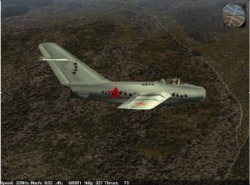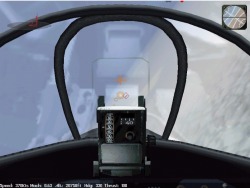|
MiG Alley Beta
by Ron "Baron01" McMasters |
||||
|
As most of you already know, cornering speed is very important in a dogfight. I found that maneuvering between 350-400 knots worked well with the F-86. In the F-80, it depends on your mission. I like dropping bombs and shooting rockets at 250-300 knots to make good approaches, but in a dense AAA environment, 350-400 works well for both ingress and egress. Overall, I found the flight characteristics were consistent and acceptable enough to be called realistic. Deep stalls, g forces, high-speed buffeting, turning radius dependent upon speed, climb and dive rates, and acceleration rates all seemed well within actual aircraft limits. F86 vs MiG 15 The F-86 was not as agile as the MiG 15, especially at higher altitudes. But the MiG-15 did not have hydraulic controls like the F-86. For the communist pilot, it was all strength and endurance when flying this fighter. That should, at the very least, translate into fatigue and slower reaction times for the MiG AI pilot, but it doesn't seem that way. At high speeds, MiGs could have real problems coming out of dives or maneuvering onto your tail. I was a bit disappointed to find that, at low altitudes where the MiG should encounter severe buffeting and control problems at high speed, the AI didn't seem to suffer. However, when I actually flew the MiG, it worked as advertised. That plane bounced all over the sky. At higher altitudes, your F-86 is clearly outmatched by the MiG, so I'd recommend staying at medium to low altitude. I think the game should be tweaked a little for lower altitude fights. The F-51, while no match for the MiG-15's speed and cannon, should be able to out-turn its adversary every time. Yet it's turning radius doesn't always reflect that fact. That said, the F-51 is a fun airplane to fly (it was re-designated F-51 from the older P-51 when "pursuit" was dropped from Air Force terminology).
 Spins were realistic. I especially liked the engine flameouts. Again, the manual didn't tell me this, but I knew to retard the throttle to idle before attempting engine restart. I also liked the fact that AI pilots would stall and depart controlled flight under the right conditions. I witnessed several MiGs auger in without my ever having fired a shot. If your airplane becomes damaged, you will see that damage on the wings, and on the fuselage in the form of bullet holes when looking from the external view. I would have liked to see a little more variety in damage to flaps, tail, and wings, like chewed up control surfaces, twisted airframe damage, etc. |
 Damage Modeling You will also notice problems controlling the plane, depending on the extent of the damage. It might be slight, or it might become progressively worse until you depart controlled flight. Or the plane might just suddenly explode. When you feel and/or hear the AAA or enemy pilots plinking at your aircraft, you had better take a look at the damage because there is no other way to tell unless your plane begins to get "mushy" or begins to lose control/power. By then, it's often too late. Refer to the eject procedures above. On the downside, I found it extremely easy to over-control the aircraft, even with the dead zone set at "Large". Now, I know I just said the flight characteristics were realistic. But, like English, there are exceptions. If I got too close to the ground, I could just snap it into the vertical for an instant, then level off. The aircraft would react instantly, keeping me from plowing into the ground, but with little to no buffeting, stall, or blackout. In reality, the F-86 was nimble, but not quite that quick. Pitch and roll were almost instantaneous, while yaw was a bit slower. It was probably a problem with my particular joystick, but I found it too easy to over-control the aircraft. Landing sequences in the beta still need work.. they are far too forgiving. Also, the view and AOA when landing seems off. Furthermore, the aircraft tends to yo-yo quite a bit at lower speeds, then just sort of pancakes onto the ground. I was also disappointed in the crash landing sequence (gear up) because my airplane exploded every time, no matter how well I set it down. Also, I was surprised the aircraft didn't sustain any damage when lowering the flaps or gear at high speeds. Winds and gusting conditions don't seem to be present, even though tower may report it as such. I landed downwind with high winds, including crosswinds, all with absolutely no problem. Even damage didn't seem to adversely affect my landings. Another oddity gave me trouble at first, too. When firing the guns, the aircraft's nose has a tendency to pitch up. Once that happens, it's difficult to put the pipper back on the target, especially when you're travelling at 350-400 knots. I grew weary of maneuvering behind a MiG, only to have the nose come off target at the firing of a few bursts. (Ed. This seems to be related to the gun camera on some systems. Try turning it ON or OFF.) Go to Part IV
|
|||
|
Copyright © 1997 - 2000 COMBATSIM.COM, INC. All Rights Reserved. Last Updated November 20th, 1999 |
||||
